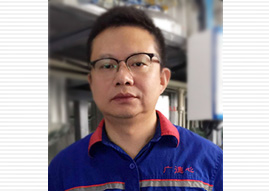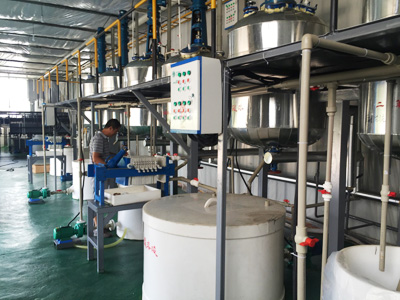Scandium: an element at initial stage with promising future
----Interview with Li Huanxin, Chairman of Codos (Shanghai) Technology Development Co., Ltd.
- Asian Metal: Good Morning, Mr. Li, thank you for accepting the interview of Asian Metal. Could you please introduce your company and your main business briefly?
- Mr. Li: Codos (Shanghai) Technology Development Co., Ltd. (“Codos Technology” or the “Company”) has been engaged in the production and sales of non-ferrous and ferrous metals as well as the trading of related upstream and downstream products at home and abroad. Our Company began producing scandium oxide and scandium metal from 2015 with crude scandium production capacity equivalent to 6tpy of scandium oxide and high purity scandium oxide production capacity of 4tpy.
- Asian Metal: Thank you for your introduction. Would you please give us a brief introduction of your career?
- Mr. Li: After graduating from the Department of Materials of the Central South University (CSU) in 1992, I started to work in Hunan Valin Xiangtan Iron and Steel Co., Ltd. (XISC) and was mainly engaged in the technology, production and sales management. I set up a company in 2008, focusing on the production of nonferrous metals as well as the trading of nonferrous and ferrous metals at home and abroad.
- Asian Metal: Scandium is the focus of this interview. As an element with a promising future, what do you think is the value of scandium? Can you give us a detailed description of its applications and features? Thank you!
- Mr. Li: The applications of scandium have been restricted by its high prices and limited supply. However, we can say that the products with scandium as an additive have the best comprehensive performance. The performance of many products can be improved by several times with the addition of scandium. Major applications of the material are as follows:
- (1) The scandium-sodium lamp used in the outdoor venues can penetrate fog and its photoelectric efficiency is four times higher than that of incandescent lamp. At present, The United States and Europe all use scandium-sodium lamp as the main lighting source for the outdoor venues, using tens of millions each year.
- (2) When the scandium is added to the laser source, the transmission power can be increased by 3 times, so the United States and Japan use a large amount of the material in the military industry.
- (3) The addition of scandium to some fission reactions in petrochemical industry can raise the reactivity by over 100 times.
- (4) At present, scandium is mainly used in the solid oxide fuel cell (SOFC). Scandium is used as the electrolyte component in the fuel cell, most commonly as scandia stabilized zirconia (ScSZ), which can greatly improve the power generating efficiency and reduce the reaction temperature when compared with its substitutes.
- (5) Aluminum alloy is another major application area for scandium. Aluminum alloys with scandium as an additive have the best strength, weldability and plasticity. However, those alloys are only used in aerospace, aviation, high performance aircraft due to high prices and limited supply. For example, the re-entry capsule of the Shenzhou spacecraft uses high-performance aluminum-scandium alloy.
- (6) Scandium plays an irreplaceable role in optoelectronic materials, special ceramics, nuclear industry and other fields.
- Asian Metal: Scandium is one of the rare earth elements, but it is not associated with the other 15 elements. Could you please tell us something about its history, application development, price changes as well as supply and demand?
- Mr. Li: Scandium is not rare in the earth's crust whose abundance is similar to that of beryllium, boron, strontium, tin, germanium, arsenic, selenium and tungsten, but almost no single ore with rich scandium content has been discovered. Most scandium is found as an associated mineral. In addition, the extraction technology is very complex and costly, so its price was several times more expensive than that of gold, limiting its application. The scandium output was only around 100kg in 1990.
- Two important applications have played a decisive role in the development of scandium. The first is the high performance Mig Fighter produced by the former Soviet Union using scandium-aluminum alloy. This application was widely known after the collapse of the Soviet Union in early 1990s, which caused the output of scandium to rise from hundred kilograms to tonnes. Additionally, its price, which was four times more expensive than that of gold, witnessed the first sharp fluctuation. The second is the application of scandium oxide in the SOFC by new energy companies represented by Bloom Energy in United States at around 2010s, causing scandium output to reach 10t or so. Meanwhile, scandium oxide prices also rebounded from the lowest point of RMB6,000/kg to around RMB20,000/kg, hitting a new high, with the actual and planned capacity also reaching the level of around 100t.
- Asian Metal: What do you think is the fundamental factor affecting the value realization of scandium?
- Mr. Li: The basic reason for impeding the value realization of scandium is the cost and price. However, with the recent remarkable development of the scandium industry, its prices will become acceptable for many industries. Especially its application in the aluminum alloy area will become more promising. The second reason is that many downstream industries do not understand the development of the scandium industry in recent years and they worry about that the supply is insufficient and the cost is uncontrollable.
- Asian Metal: Why should we rediscover the value of scandium again? Are there any breakthroughs in its applications or manufacturing processes?
- Mr. Li: Civil aviation industry and related enterprises are cautious about using aluminum-scandium alloy to take place of aluminum-lithium-magnesium alloys and other alloys for fear of supply shortage. However, the current domestic production capacity of scandium is nearly 100tpy with several Chinese companies planning to construct production lines with annual production capacity of several hundred tons. In addition, several companies in Australia, the USA and Japan also plan to extract scandium and have entered the initial stage of implementation with Australia having made significant progress in extracting high grade scandium resources.
- Asian Metal: As far as you know, what is the latest development in the scandium industry? Are there any changes in resources, processes, costs, scale and so on?
- Mr. Li: Great progress has been made in the scandium industry in recent years. Details are as follows:
- (1) Great progress has been made in the extraction of scandium resources. The output of scandium extracted from the waste acid in the production of titanium dioxide has increased remarkably. Besides, Chinese firms have also achieved mass production of scandium extracted from the production of zirconia. US-based Niocorp plans to extract associated scandium when producing ferroniobium. Australian-based Clean teQ has built the pilot production line to extract associated scandium in the production of nickel and cobalt. Australian-based Platina is also developing all of their scandium resources. UC Rusal has also constructed pilot production lines to extract scandium from bauxite resources. Some Chinese companies are extracting scandium from chlorinated titanium fume. All of these examples indicate that scandium is not rare and can be found everywhere.
- (2) The production capacity of scandium has risen substantially. With scandium prices soaring in 2010, China has built production capacity of nearly 100t with planned capacity of several hundred tons, which can fully meet the potential market demand. Potential resources will be developed and potential capacity will also be released at any time if the demand increases. The scandium industry already has the ability to build production capacity of several thousands tonnes and actual output of several hundreds tonnes of scandium oxide.
- (3) Various extraction technologies have been developed with different advantages. Extraction technologies, which have been designed in terms of the sources of scandium, tend to mature. Great progress has been made in the aspects of impurity content, production capacity, costs and so on, which can better meet downstream customers’ diversified requirements.
- (4) The production cost has dropped dramatically. Scandium oxide prices have dipped below RMB6,000/t (USD887/t), which has been longed for a long time by the aluminum industry. In the past few years, the decrease of the cost can mainly be attributed to the growth of the scandium industry. The discovery of some high-quality scandium resources and the optimization of production processes also play an important role in the cost reduction. Some low-cost resources and processes may also emerge with the development of the scandium industry.
- Asian Metal: At the scandium symposium held by Asian Metal during the 9th International Rare Earth Summit on May 11-12, insiders proposed to establish the Association of Chinese Scandium Industry with the aim of stabilizing prices and expanding downstream markets. What do you think about this? What can Asian Metal do for the scandium industry?
- Mr. Li: The two important opportunities which promoted the development of the scandium industry mentioned previously were created by downstream industries. I hope the next important development chance is created by scandium enterprises, which means let the downstream industries fully understand that great improvements have been made in the cost, production technology and supply capacity, so that they can be assured to develop more and better applications.
- As an information provider, Asian Metal provides the most comprehensive and in-depth information of the scandium industry. We hope Asian Metal can make efforts in the following directions: firstly, reporting the development of the scandium industry timely; secondly, setting up a special column to report the price changes and market supply and demand; thirdly, becoming the promoter and organizer of the Association of Scandium Industry as well as the messenger of scandium suppliers and users.
- Asian Metal: Ok, we will try our best to devote to these aspects. So what is your production situation at present? What are your business and development plans in H2 of 2017?
- Mr. Li: Our Company has two key works to do in the H2 of this year. Firstly, Upgrading supporting facilities and improving the production automation level. With an annual capacity of 6t of crude scandium and 4t of high purity scandium oxide at present, we plan to release the remaining production capacity for the high-purity material. In addition, we will further improve the quality of products by raising the automation level of the production line; secondly, strengthening communication with downstream industries, especially excellent enterprises in the aluminum alloy industry, to jointly promote the application of scandium in the aluminum alloy industry.
- Asian Metal: Thank you for sharing your opinion and your support to Asian Metal. Wish your company a bright future! We believe scandium which had been more expensive than gold will have a promising future.

